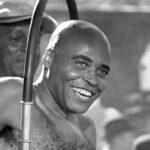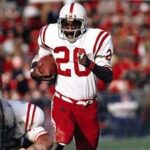Lionel Taylor: The First 100 Catch Man
It was 50 years ago that the October Sports Then and Now Vintage Athlete of the Month became the first player in professional football history to catch 100 passes in a single season.
Reaching the century mark for receptions in a season has been accomplished by at least one NFL player in every season except one since 1990, but when Lionel Taylor caught 100 passes in just 14 games for the Denver Broncos it was an accomplishment that had never previously been approached.
In fact, before Taylor caught 92 passes in the first year of the American Football League in 1960, no professional football player had ever caught more than the 84 passes caught by Tom Fears during the 1950 NFL season.
A 6-foot-2, 215 pound end out of New Mexico, Taylor saw action in eight games for the Chicago Bears without making a reception in 1959, but a move from the Bears to the new AFL for the 1960 season proved to be exactly what Taylor needed to jump start his career.
One of the goals when the AFL started in 1960 was to create a new brand of football that placed greater emphasis on the passing game and provided fans with a plethora of exciting plays. The high-scoring early days were often compared to a pinball machine as offense and scoring was emphasized much more than defense.
In 1960, the Broncos scored 24 or more points eight times and averaged more than 22 points per contest, but they allowed 20 or more points 11 times and ranked seventh in the league allowing 27 points per game on their way to a 4-9-1 record.
Broncos quarterback Frank Tripucka set a professional football record in 1960 by attempting 478 passes, which was exactly 100 more than Johnny Unitas tossed to lead the NFL that season and 94 more than the NFL record of 382 attempts, which had been set by Tobin Rote in 1954.
Taylor was the primary target for Tripucka as he caught a new professional record 92 passes for 1,235 yards and 12 touchdowns.
The following season Tripucka and George Herring combined for 555 pass attempts and Taylor became the first player in professional football history to catch 100 passes in a season. Typically during that era wide receivers were used to spread the field and catch deeper passes, but Taylor functioned more like wide receivers of the modern NFL catching more possession passes. In 1961 he gained 1,176 yards for an average of 11.8 yards per catch.
Taylor went on to lead the AFL in receptions in 1962, 1963 and 1965. The only year he didn’t top the league during that stretch was in 1964 when Charley Hennigan of the Houston Oilers broke Taylor’s record by catching 101 passes. That mark would last for 20 years before Art Monk became the first NFL player with 100 catches in a season in 1984.
In 1965 Taylor earned first team All-Pro honors for the fourth time in his career with 85 receptions for 1,131 yards and six touchdowns. The 1966 campaign was his last in Denver as Taylor’s numbers declined to 35 receptions and 448 yards.
Unfortunately for Taylor and the Broncos, having a high-flying offense didn’t lead to many victories. Denver never won more than four games in a season during Taylor’s seven seasons with the team.
In 1967 he moved to the Houston Oilers and caught 24 passes in two seasons.
At the time of his retirement, Taylor’s 567 catches and 7,195 yards were the most in AFL history and second overall behind only Raymond Berry.
Perhaps because he played during the early years of the AFL and posted his numbers on bad teams, Taylor has never been considered as a finalist for the Pro Football Hall of Fame. He also is often forgotten when discussing the top receivers in AFL history as Lance Alworth, Don Maynard, Hennigan and Art Powell are usually the first mentioned.
After retirement, Taylor spent seven seasons as the receivers coach for the Pittsburgh Steelers and helped develop Hall of Famers John Stallworth and Lynn Swann as well as Pro Bowl receiver Frank Lewis.
He also was the offensive coordinator for the Los Angeles Rams and served as head coach at Texas Southern College and for the England Monarchs in the WLAF.















